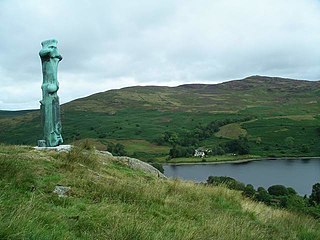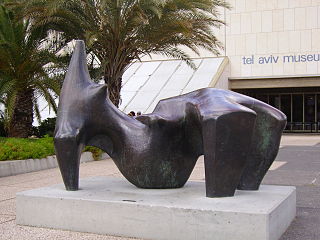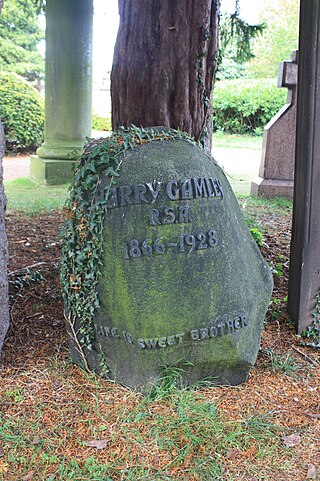Gallery
- John the Baptist
- Visitation
- Standing Figure
- King and Queen
- Glenkiln Cross
- Two Piece Reclining Figure No.1
Glenkiln Sculpture Park was a sculpture landscape in the historic county of Kirkcudbrightshire in Dumfries and Galloway, south-west Scotland.
After one of the bronze statues was stolen all the statues except the Glenkiln Cross and reclining figures have been removed.
It comprised six sculptures placed in a moorland setting around Glenkiln Reservoir. [1] The sculptures were located around 4 kilometres (2.5 mi) north-west of Shawhead, and 12 kilometres (7.5 mi) west of the town of Dumfries.
Between 1951 and 1976, local landowner Sir William "Tony" Keswick (grandson of William Keswick) assembled a collection of works by Auguste Rodin, Henry Moore, and Jacob Epstein. [2] Keswick worked with the artists in siting their works in a natural landscape, and commissioned works. [3]
On 13 October 2013, the BBC reported that Standing Figure had been stolen. [4]
All the sculptures except "Glenkiln Cross" have been removed for security reasons on police advice and are no longer available to view. [5]
The sculptures formerly on show are:
There is also a memorial to commemorate the diamond wedding of Sir William and Lady Keswick and another to Peter Fleming the travel writer and adventurer, friend of the Keswicks, who used to shoot on the estate.

François Auguste René Rodin was a French sculptor generally considered the founder of modern sculpture. He was schooled traditionally and took a craftsman-like approach to his work. Rodin possessed a unique ability to model a complex, turbulent, and deeply pocketed surface in clay. He is known for such sculptures as The Thinker, Monument to Balzac, The Kiss, The Burghers of Calais, and The Gates of Hell.

Sir Jacob Epstein was an American-British sculptor who helped pioneer modern sculpture. He was born in the United States, and moved to Europe in 1902, becoming a British subject in 1910.

The Thinker is a bronze sculpture by Auguste Rodin, situated atop a stone pedestal. The work depicts a nude male figure of heroic size sitting on a rock. He is seen leaning over, his right elbow placed on his left thigh, holding the weight of his chin on the back of his right hand. The pose is one of deep thought and contemplation, and the statue is often used as an image to represent philosophy.

The Kröller-Müller Museum is a national art museum and sculpture garden, located in the Hoge Veluwe National Park in Otterlo in the Netherlands. The museum, founded by art collector Helene Kröller-Müller within the extensive grounds of her and her husband's former estate, opened in 1938. It has the second-largest collection of paintings by Vincent van Gogh, after the Van Gogh Museum. The museum had 380,000 visitors in 2015.
Philip Henry Christopher Jackson CVO DL is a Scottish sculptor, noted for his modern style and emphasis on form. Acting as Royal Sculptor to Queen Elizabeth II, his sculptures appear in numerous UK cities, as well as Argentina and Switzerland.

Henry Spencer Moore was an English artist. He is best known for his semi-abstract monumental bronze sculptures which are located around the world as public works of art. Moore also produced many drawings, including a series depicting Londoners sheltering from the Blitz during the Second World War, along with other graphic works on paper.

The Walking Man is a bronze sculpture by the French sculptor Auguste Rodin. This sculpture was made in 1907.

Leeds Art Gallery in Leeds, West Yorkshire, England, is a gallery, part of the Leeds Museums & Galleries group, whose collection of 20th-century British Art was designated by the British government in 1997 as a collection "of national importance". Its collection also includes 19th-century and earlier art works. It is a grade II listed building owned and administered by Leeds City Council, linked on the West to Leeds Central Library and on the East via a bridge to the Henry Moore Institute with which it shares some sculptures. A Henry Moore sculpture, Reclining Woman: Elbow (1981), stands in front of the entrance. The entrance hall contains Leeds' oldest civic sculpture, a 1712 marble statue of Queen Anne.

The Franklin D. Murphy Sculpture Garden is a garden located on the campus of the University of California, Los Angeles. It is run by the Hammer Museum.

Upright Motive No. 1: Glenkiln Cross is a bronze sculpture by Henry Moore, cast in a number of copies in 1955–56. It was the first of a series of narrow vertical sculptures by Moore, who compared them to totem poles.

Saint John the Baptist (preaching) is a bronze sculpture, by Auguste Rodin.

Modern sculpture is generally considered to have begun with the work of Auguste Rodin, who is seen as the progenitor of modern sculpture. While Rodin did not set out to rebel against the past, he created a new way of building his works. He "dissolved the hard outline of contemporary Neo-Greek academicism, and thereby created a vital synthesis of opacity and transparency, volume and void". Along with a few other artists in the late 19th century who experimented with new artistic visions in sculpture like Edgar Degas and Paul Gauguin, Rodin invented a radical new approach in the creation of sculpture. Modern sculpture, along with all modern art, "arose as part of Western society's attempt to come to terms with the urban, industrial and secular society that emerged during the nineteenth century".

Reclining Figure 1969–70 is a bronze sculpture by English artist Henry Moore.

Draped Seated Woman 1957–58 is a bronze sculpture by the British artist Henry Moore, cast in an edition of seven in the 1950s. The sculpture depicts a female figure resting in a seated position, with her legs folded back to her right, her left hand supporting her weight, and her right hand on her right leg. The drapery emphasises the female figure, but the facial features are abstracted and barely picked out.

Henry Snell Gamley (1865–1928) was a Scottish sculptor specialising in war memorials and sculpture on tombs. He was however also responsible for other figurative sculpture on prominent Edinburgh buildings such as the Usher Hall and works at Holyrood Palace.

Knife Edge Two Piece 1962–65 is an abstract bronze sculpture by Henry Moore. It is one of Moore's earliest sculptures in two pieces, a mode that he started to adopt in 1959. Its form was inspired by the shape of a bone fragment. Moore created the sculpture from an edition of 10 working models in 1962; these working models are now in public collections. Moore created four full-size casts between 1962 and 1965, with one retained by him. The three casts are on public display on College Green in Westminster, London; Queen Elizabeth Park in Vancouver; and the garden at Kykuit, the house of the Rockefeller family in Tarrytown, New York. Moore's own cast is on display at his former studio and estate, 'Hoglands' in Perry Green, Hertfordshire in southern England. A similar work, Mirror Knife Edge 1977, is displayed at the entrance to I. M. Pei's east wing of the National Gallery of Art in Washington, D.C. The Westminster cast was donated by Moore through the Contemporary Art Society to what he believed was the City of London, but its actual ownership was undetermined for many years. The Westminster cast subsequently fell into disrepair, and was restored in 2013 after it became part of the British Parliamentary Art Collection; it was granted a Grade II* listing in January 2016.

King and Queen is a bronze sculpture by Henry Moore, designed in 1952. It depicts two figures, one male and one female, seated beside each other on a bench, both facing slightly to the left. It is Moore's only sculpture depicting a single pair of adult figures. Moore's records suggest it was originally known as Two Seated Figures.

Recumbent Figure 1938 (LH191) is an early sculpture by Henry Moore. It was commissioned by the architect Serge Chermayeff for his modernist villa at Bentley Wood, near Halland, Sussex. At the time it was made, it was Moore's largest stone sculpture. It was donated to the Tate Gallery in 1939, making it the first example of Moore's work in a public collection.

Reclining Figure (Lincoln Center) (LH 519) is a statue by Henry Moore. The original two-part bronze statue of a human figure was commissioned for the Lincoln Center for the Performing Arts in New York City, where it has been displayed outdoors since 1965 in a pool of water to the north of the new Metropolitan Opera House. Other copies in plaster or bronze exist, and are displayed in other cities.
55°05′02″N3°49′12″W / 55.083779°N 3.819945°W